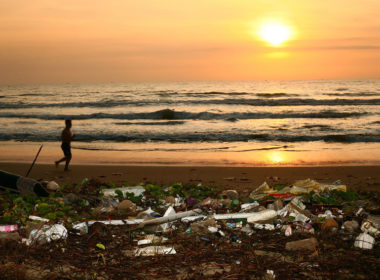
Several schools are investigating how the geographical location of a local beach impacts the amount and types of trash that wash up on it over several weeks. If you would like to contribute data to this investigation, click on the blue Instructions link above for information about how to collect and sort trash.
Instructions / How to do this investigation
Protocol
Advanced Preparation:
- Plan to collect trash one day on a specific local beach (weather and tide dependent).
- Plan to collect within 10m of the high tide line (either side of the high tide line is acceptable).
- Please have safe collection strategies in place and review them with students in advance and on the day of collection. See the Ocean Conservancy’s Before the Cleanup page for safety planning.
- Mark off a 50-meter stretch of beach at the high tide mark. This will be your collection area. Depending on beach and class size, you may have multiple 50-meter stretches of beach marked off. each time.
- Acquire enough garbage bags of the same type, so that their weight is consistent (it will need to be subtracted out later). You may use different garbage bags on different days if necessary; you’ll just need to weigh any new style bags.
Field Instructions:
- Review safety guidelines with students, then dispense the necessary safety and collection gear.
- Use an iPad or camera to take a picture of your collection area before picking up any of the trash. Take the picture so that it captures the entire length of your 50-meter collection area. Take the picture from the same location each day you collect trash.
- Record the latitude & longitude of your collection area.
- Record the date and time of each collection.
- Record the tide.
- Gather all the trash in your marked collection area and put it into garbage bags to bring back to the classroom for sorting.
Weighing and Sorting Instructions:
- Weigh a single, empty trash bag (pounds). Count the total number of garbage bags you filled on a collection day and multiply it by the weight of a single empty bag. You will need to subtract out this weight later.
- Weigh each garbage bag containing trash (pounds) and total these numbers.
- Subtract the weight calculated in step 1 from the weight calculated in step 2 (Step 2 weight – Step 1 weight). This is the weight of trash collected that you will report in WeatherBlur.
- Have groups of students each take one bag of trash to sort and tally the contents. Sorting Checklist HERE
- Students should sort the trash into piles based on this checklist:
- Number of plastic beverage bottles
- Number of plastic bottles (i.e. blech, laundry detergent, oil, etc.)
- Number of plastic (and similar) grocery bags (i.e. Walmart, etc.)
- Combined number of plastic utensils, plates, cups
- Other plastic items found
- Number of metal items found
- List of metal items found (if identifiable)
- Number of glass items found
- List of glass items found (if identifiable)
- List of fishing gear found
- Other types of trash found (that don’t fit in other categories)
- Beach name
- Students should sort the trash into piles based on this checklist:
- Once the trash is sorted, students should count the number of each type of trash and record it on the checklist. Have each group tally their trash on a printed checklist first. Then groups can combine their tallies and someone can upload the data into a single data form for that collection date* (see note below).
- Consider assigning students roles, for example- sorter, counter, recorder.
* NOTE: When you enter your trash data on the WB site, be sure the latitude, longitude, date, and time at the top of the data entry form match the information for when you collected the trash!


Comments
Tell us how your data collection/analysis is going